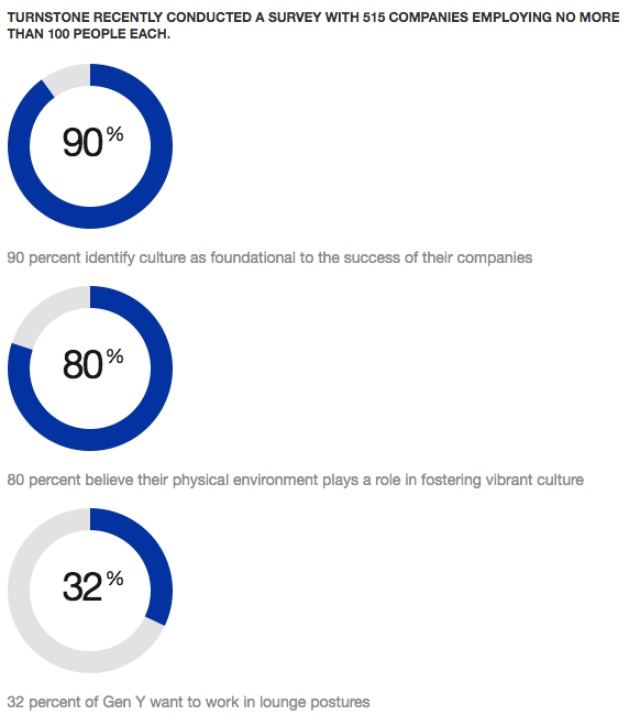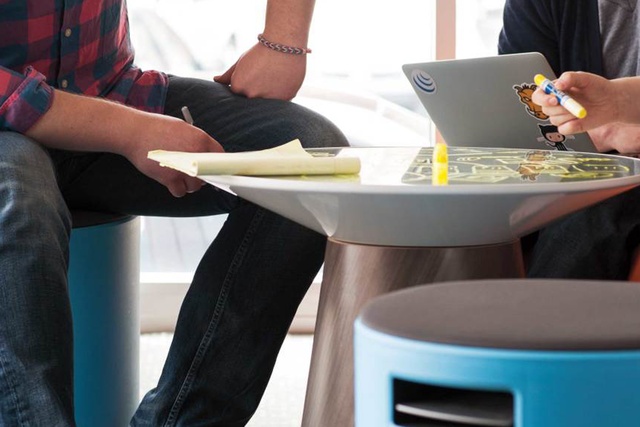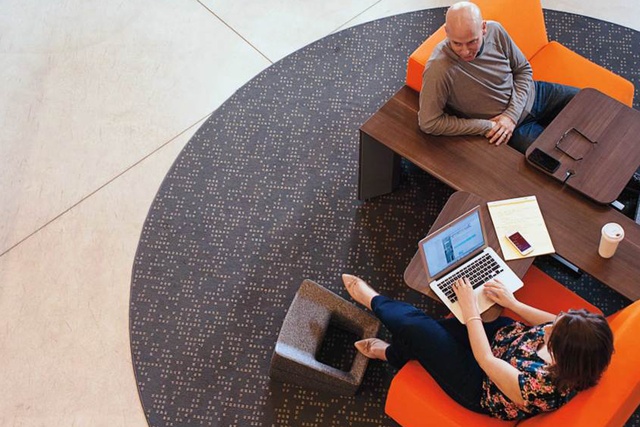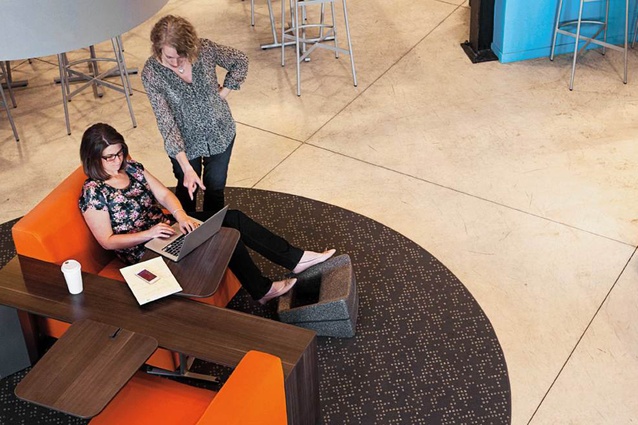Igniting a sense of startup culture
Partner Content: A Steelcase paper on reconnecting with the startup mindset without getting weighed down by the sheer scale of a large enterprise.
Authenticity. Personality. Agility. Passion. Startups have them all in spades, powering innovation, pushing boundaries and propelling the dramatic impact entrepreneurs have on the marketplace. They run their companies with heart and transparency, fueling a special kind of culture that has become the envy of established organizations searching for that same energy and vibe. Startups are small and nimble, and they like it that way. Because, let’s face it: their unique, infectious culture makes it easy to get things done.
But what happens when larger leading organizations want to activate more grit, authenticity and passion in their environments? How do “intrapreneurs,” the innovative team leaders and space-creators in big businesses, reconnect with that startup mindset without getting weighed down by the sheer scale of a large enterprise?
Turnstone has been asking these questions of entrepreneurs in startups and of intrapreneurs within ecosystems of large organizations. Our exploration of culture and its organic link to the physical workplace has produced compelling observations about shifting behaviors.
Here’s what we’re learning about entrepreneurs looking to accelerate business results by leveraging their culture and space, and about intrapreneurs looking to reinvent the culture of their large organization.
FOSTERING “NON-CORPORATE CULTURES”
A casual, non-corporate environment, or what we’re calling “startup culture,” is a highly prized component of countless entrepreneurial ventures. It puts personalities on display and allows people to have fun together and work in ways that best suit them. This culture translates as “unbuttoned and non-corporate”—a flexible, authentic environment that engages employees, allowing them to experience a sense of meaning and belonging.
“We believe that space is a tool to build culture, engage human capital and, over time, improve a brand,” says Kelly Ennis, founder and managing principal at Baltimore’s The Verve Partnership, a client-focused architectural firm dedicated to marrying design-driven conversations and strategic business opportunities. As a designer, Ennis recognizes that achieving startup culture requires intentionality.
“Brand is more than just a logo on the wall or a certain color of paint. It’s who you are at the heart and perhaps more importantly, who others think you are,” says Ennis. “Culture and identity are so intertwined, and that’s where architects and designers can really help by providing a place that reflects and engages both of those things equally and authentically.”
Sam McBride, co-owner, RxBar, Chicago, recognizes the role space, culture and brand play in client relationships and company growth.
“Our protein bars only have six to eight ingredients. They’re very clean and include only the highest quality ingredients. When we planned our office, we wanted to reflect the very thing we are delivering to the market, so we created a physical space that’s really clean, modern and simple,” explains McBride. “Our customers can see that for us, quality and simplicity extend beyond what’s inside the wrapper and into our daily surroundings. It’s authentic because we’re living what we sell.”
A recent study conducted by Turnstone of over 500 small business owners confirmed this important connection. The study found that 80 percent of respondents recognize that physical space plays a direct role in fostering vibrant culture, while 90 percent stated that culture is not just a great perk but an important contributor to the success of the company.
Though small companies often start out with a cool office vibe, we’ve learned that maintaining it over the long haul is more difficult—especially once companies hire their 10th employee. As founders begin to worry about instituting norms, policies and procedures to keep their businesses running smoothly, some find that the pressures of growing a successful business curb the carefree nature they once had when approaching life in the office.
At the same time, intrapreneurs within larger leading global organizations are feeling a similar, yet distinct, pressure to be more nimble and agile. And although well-appointed surroundings, ample resources and years of experiences separate them from some younger companies, intrapreneurs are like-minded in their willingness to challenge the status quo.
Enrique Godreau III, senior vice president of development at UPGlobal, a nonprofit dedicated to strengthening communities by spurring grassroots leadership and entrepreneurship, has spent years interacting with startups and innovative thinkers within large organizations. He notes that many financially successful companies continue down the path that first brought them to the
top, staying focused on optimizing their product or service offerings. Intrapreneurs, on the other hand, push boundaries and ask tough questions.

“It’s so easy to believe that the way things are, are the way they’re supposed to be. Intrapreneurs recognize that successful businesses have to be willing to question what they’re doing today—not merely to optimize what’s been done in the past,” says Godreau. “Having a vision for this kind of culture is not rebellious, it’s disruptive. And pursuing this culture doesn’t just authorize, but charges people, to be disruptive and authentic and innovative.”
Intrapreneurs also realize they are competing with startups to attract, retain and engage talent. Whether they lead teams in product development, HR, IT, marketing, sales or the C-suite itself, intrapreneurs know that if their spaces don’t reflect cultural ideals, their organization won’t stay ahead.
NEW POSTURES IN START-UP CULTURES

Sitting in diverse postures, especially lounging, is an immediate cue to workers that the culture is different and more relaxed. Turnstone research has shown that offering employees choices of where and how they work and giving them control over their day is a pivotal component of startup culture. Encouraging a variety of postures is vital to creating an engaging workplace.
Alternative work postures can provide that freedom and help nurture a startup culture vibe. Turnstone research has revealed that of professionals aged 18–34 years, a whopping 32 percent prefer to work in lounge settings filled with ottomans, stools or other casual options that offer comfort and enhance productivity.
Brian Hoffman, head of business development at Startx, a non-profit accelerator located in the heart of Silicon Valley, noted this trend with his own staff. “We wanted people to work upstairs in the space we had designed for them and at the desks we had installed for them to use, but people naturally wanted to be in lounge settings.”
The pace of today’s office has also made standing-height tables and desks sought-after destinations, as teams iterate and think in snatches of time between meetings. Rather than settling in at seated workstations to respond to emails, we’ve seen people regularly gravitate to height-adjustable tables or standing-height work surfaces where they can quickly move in and out of tasks.
“Why should you need a doctor’s note to get a standing desk?” asks J. Kelly Hoey, New York City-based angel investor, speaker and networking strategist. “If we want the best from our people, why don’t we create a work environment that can evolve with changing workstyles? We should recognize that people work in different ways, and at different times of the day you might have different needs to be most effective.”
EMBRACING A DIY SPIRIT

There’s a strong link between curation and the “do-it-yourself” spirit of many entrepreneurs and intrapreneurs. Whether applying unique choices in materiality or blanketing offices with artifacts that represent the founder’s passions, entrepreneurs have ignited a race for the most exciting workplaces. They leverage social media photo sharing to highlight what they like and what inspires them, and then relentlessly pursue curating a space to match.
Dana Verbosh, interior designer for global design firm Gensler, shares a story about a young tech startup in Baltimore. Originally working from a basement, this client recently acquired space in an up-and-coming Baltimore neighborhood where they will occupy the third floor of a 1900s theater building rich with architectural details and open 23-foot ceilings.
She explains, “This group knows that being thoughtful about design helps move a space toward culture, so we’re helping them curate reclaimed wood from old Baltimore row homes to create a one-of-a-kind feature wall and some other special pieces. Our job is to make sure we tell a visually compelling story while ensuring the space delivers commercial durability.”
GETTING STARTED
What do these trends mean for entrepreneurs, people in real estate, space creators in larger organizations, facilities managers, incubators and disruptive thinkers everywhere? Is it really possible to ignite—or reclaim—a sense of “startup culture” in your workplace?
We believe the answer is, “Absolutely.” Here’s how you can get started:
Tip #1: Make space reflect culture

Push the envelope with materiality and choose progressive finishes to create an energetic vibe or a warm, residential feel with commercial-grade quality. Embrace a DIY spirit by adding unique statement pieces into your space that reflect your inner-artist and put your passions on display.
“People are trying to express themselves. To create an identity. To define a brand. And it manifests itself in the space and the collection of objects they curate.” –Tom Polucci, director interior design, HOK
Tip #2: Champion disruption

Support the intrapreneurs in your ecosystem by giving them a space devoted to unleash creativity and true freedom to innovate. If possible, physically move intrapreneurs away to help activate a new sense of startup culture. Champion their disruptions as vehicles that will move you toward a stronger, more relevant company.
“Intrapreneurs communicate their new ideas with flip charts, post-it notes and drawings. You need a space that supports this kind of interaction. You need a space to showcase all these things so the innovators can tell the story of how their ideas will come to be.”–Enrique Godreau III, senior VP development, UPGlobal (A non-profit dedicated to strengthening communities by spurring grassroots leadership and entrepreneurship.)
Tip #3: Embrace authenticity and agility

Add lounge spaces and standing-height elements to to complement ergonomic seating. Send the message that you trust and support your team to choose the places and postures that best encourage productivity and focus for them. Intentionally design other spaces that promote quiet, collaboration and fun, so that people can truly love the way they work.
“The most popular areas are the cafés, which are more like casual bistros with lounge areas. When it comes to ideation and teams working together, casual gathering opportunities are more powerful and more effective.”–Benjamin Dyett, co-founder, Grind (A Chicago and NYC-based coworking facility dedicated to creating “frictionless” work experiences.)
ArchitectureNow works with a range of partners in the A&D supply sector to source appropriate content for the site. This article has been sponsored by Workscape New Zealand.










